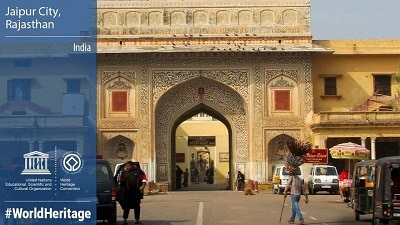At the 43rd Session of the UNESCO World Heritage Committee which is underway from June 30 to July 10, 2019 in Baku, Azerbaijan, the United Nations Educational, Scientific and Cultural Organization (UNESCO) added the ‘Pink City’ Jaipur/Walled City of Jaipur of Rajasthan, known for its iconic architectural legacy, into the list of the World Heritage Sites. The International Council on Monuments and Sites (ICOMOS) had inspected the city in 2018 after the nomination. The World Heritage Committee (WHC) acknowledged the “city’s outstanding value as a cultural property”.
Nomination
- India had proposed the nomination of Jaipur as an “exceptional urban example in indigenous city planning and construction in South Asia”, before the World Heritage Committee.
- The countries that supported India’s nomination were Brazil, Bahrain, Cuba, Indonesia, Azerbaijan, Kuwait, Kyrgyzstan, Zimbabwe, China, Guatemala, Uganda, Tunisia, Burkina Faso, Bosnia and Herzegovina, Angola, St Kitts and Nevis. Australia and Norway had initially proposed a referral, but they agreed for the inclusion of Jaipur after the debate.
About Jaipur
- The historic walled city of Jaipur in Rajasthan was founded in 1727 AD (Anno Domini) under the patronage of Sawai Jai Singh II. It serves as the capital city of the culturally-rich state of Rajasthan.
- It is located in hilly terrain and was established on the plain. It was built according to a grid plan interpreted in the light of Vedic architecture.
- It shows an interchange of ancient Hindu, Mughal and contemporary Western ideas that resulted in the form of the city
- It is an example of a late medieval trade town in South Asia and it defined new concepts for a thriving trade and commercial hub.
- The city is associated with living traditions in the form of crafts that have national and international recognition.
World Heritage Sites in India
- With Jaipur’s inclusion, the number of heritage sites across India on the UNESCO World Heritage list, increased to 38.
- It includes 30 cultural properties, 7 natural properties and 1 mixed site.
- Ahmedabad became the first Indian city to get into the list in 2017.
Other Sites in the list
- Australia’s Budj Bim Cultural Landscape: The Budj Bim Cultural Landscape in southeast Australia was added to UNESCO World Heritage Sites. It was created by the Gunditjmara nation nearly 6,600 years ago and includes remnants of elaborate stone channels and pools built to harvest eels from a lake and wetland swamp areas. It is evident to stone dwellings which counter the myth that Aboriginal peoples were simply nomadic hunter-gatherers with no established settlements or sophisticated means of food production.
- Iran’s Hyrcanian Forests: UNESCO added Iran’s Hyrcanian forests to its World Heritage List praising the area for its “remarkable biodiversity”. The ancient Hyrcanian forests in northern Iran run 530 miles (850 kilometres) along the coast of the Caspian Sea. 50 million years ago they were the home to the Persian leopard, nearly 60 other mammal species and 160 bird species.
- Iraq’s Babylon: UNESCO declared the ancient Mesopotamian city of Babylon as a World Heritage Site recognizing its “outstanding value to humanity”. It was famous for its Hanging Gardens, which were among the Seven Wonders of the Ancient World. Since 1983, Iraq had been trying to persuade for the 4,000-year-old ancient Mesopotamian city on the Euphrates River to be added to the United Nations’ list.
- The other cultural sites included in the list are the Myanmar’s Bagan, Dilmun Burial Mounds in Bahrain, the archaeological ruins of Liangzhu city in China, the Ombilin coal mining heritage of Indonesia’s Sawahlunto, the mounded tombs of ancient Japan, and Megalithic Jar Sites in Laos’ Xiengkhouang.
Reason to provide the World Heritage Site Status
UNESCO seeks to encourage the identification, protection and preservation of cultural and natural heritage around the world which are considered to be of outstanding value to humanity. This is embodied in an international treaty called the Convention concerning the Protection of the World Cultural and Natural Heritage, adopted by UNESCO in 1972.
About UNESCO:
♦ Headquarters: Paris, France
♦ Director General: Audrey Azoulay
About Rajasthan:
♦ Capital: Jaipur
♦ Chief Minister: Ashok Gehlot
♦ Governor: Kalyan Singh
♦ National Parks: Mukundra Hills (Darrah) National Park, Desert National Park, Keoladeo Ghana National Park, Ranthambhore National Park, Sariska National Park
♦ Wildlife Sanctuaries: Mount Abu WLS, Nahargarh WLS, Kesarbagh WLS, Sariska WLS, Van Vihar WLS, Sawai Man Singh WLS etc